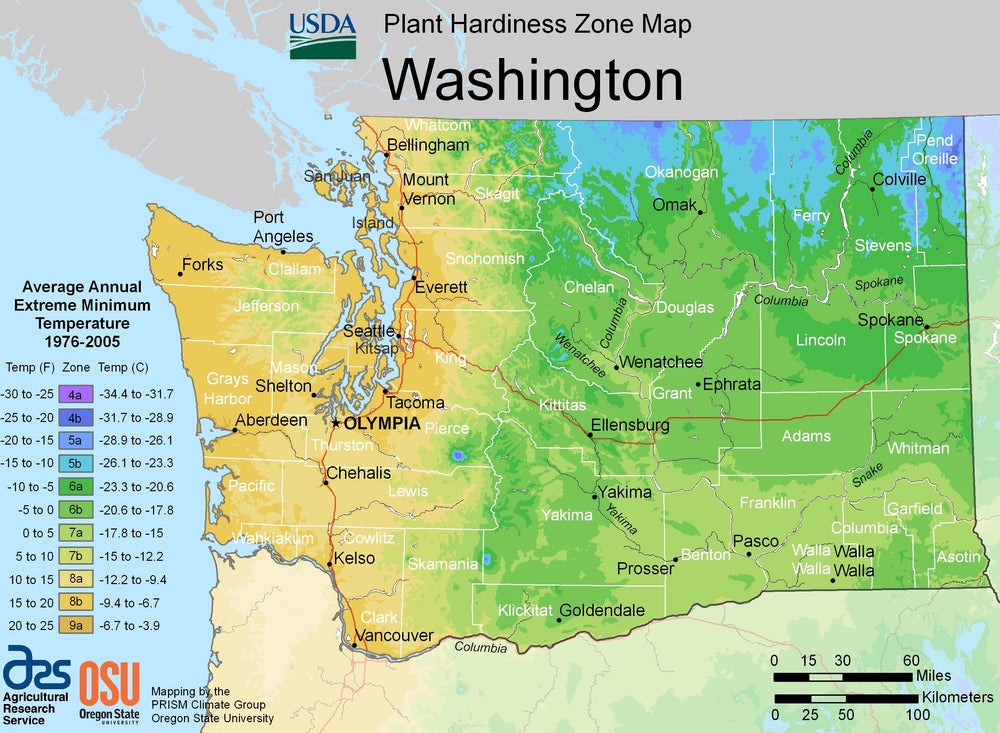Image from USDA
Characteristics of Washington Planting Region
Washington state can be divided into two distinct climate regions:
This part of the state experiences mild, humid summer days and very mild winters. Snow is quite rare outside of the mountainous region, but rainfall, clouds, and fog are common across the entire area.
The eastern part of the state will experience much hotter summers and considerably colder winters than the western region. Rainfall is minimal, while sunshine is consistent throughout the year.
Additionally, much of the state can be subjected to extreme events such as wildfires, flooding, severe storms, landslides, and even earthquakes.
The growing season varies dramatically across the region, so it’s best to find the specific frost-free dates for your area before getting started.

Hurricane Ridge Olympic National Park, Washington, USA
Challenges of Growing in Washington
1. Diverse Climate
The diversity of Washington’s climate means temperatures and frost dates can vary drastically throughout short distances across the state. Regardless of what zone or region you’re located in, many choose to use protective coverings combined with indoor growing to avoid disappointment brought on by late or early frosts.
2. Extreme Weather
Severe storms, flooding, and wildfires can all be detrimental to your garden’s success. While many of these events are beyond our control, it’s suggested to use raised garden beds and protective coverings to keep your hard work out of harm’s way.

The Benefits of Using a Greenhouse in Washington
There are a multitude of benefits to using a greenhouse in the state of Washington. Extended growing seasons, protection from extreme weather events, and avoiding damage from unexpected frosts are just a few advantages to greenhouse growing in this region. Not to mention, gardeners will be able to grow a much wider variety of vegetables without the need to transplant them at a later date.
1. Extend your Growing Season
-
Without a Greenhouse:
The average growing season can vary wildly across the state. While the lower altitude and coastal areas can experience 5-7 months of growing time, most of the state is limited to 3-4 months. Regardless of what area you’re located in, early frosts and mild weather still make growing many vegetables a challenge.
-
With a Greenhouse:
Using a greenhouse in Washington will allow you to extend your growing season to at least 8-9 months for those who live inland and potentially allow coastal gardeners to plant year-round. However, due to the high-intensity sunshine in the eastern regions, many gardeners throughout the rest of the state may also be able to experiment with year-long growing.
Learn more about specific growing dates for your area and the best vegetables to plant in each part of Washington.


Customer images of greenhouse growing in a similar climate
2. Grow a Wider Variety of Vegetables
-
Without a Greenhouse:
Many warm-season or slow-maturing plants may struggle to survive in most parts of Washington. Even in warmer coastal areas, there is a danger of late/early frosts damaging your garden. The following are some cold-hardy vegetables that can survive through cooler dips and surprise frosts:
- Broccoli
- Beets
- Kale
- Spinach
- Peas
- Turnips
- Radish
-
Endive
-
With a Greenhouse:
A greenhouse will allow gardeners in Washington to plant a much wider variety of vegetables and experiment with many long-season and warm weather crops. Some of the vegetables known to flourish in a greenhouse in this region include:
- Beans
- Brussel Sprouts
- Tomatoes
- Cucumbers
- Eggplants
- Summer Squash
- Melons
- Carrots
- Potatoes
- Cauliflower
- Onions
- Sweet Peppers
- Pumpkins
- Winter Squash
- Artichokes
- Asparagus
- Corn
- Garlic
- Lettuce
- Hot Peppers
- Parsley
- Cherry Tomatoes
- Okra
- Swiss Chard
- Rosemary
- Parsnips
-
Oregano

Tomatoes growing in a greenhouse
Why Planta Greenhouses?
- Wind resistant up to 65 mph (learn more about how our greenhouses hold up in high-altitude climates).
- Withstands a snow load of up to 98 psf (480kg/square meter).
- Made with a heavy-duty galvanized steel frame.
- Polycarbonate panels provide 100% protection against UV rays.
- The Sungrow greenhouse is bell-shaped - allows the wind, snow, and hail to slide off the sides.
- Extendable (Sungrow, Sigma and Farmer models can be extended beyond 100ft)
- Made in Europe and are exclusively imported
- Maintenance-free

